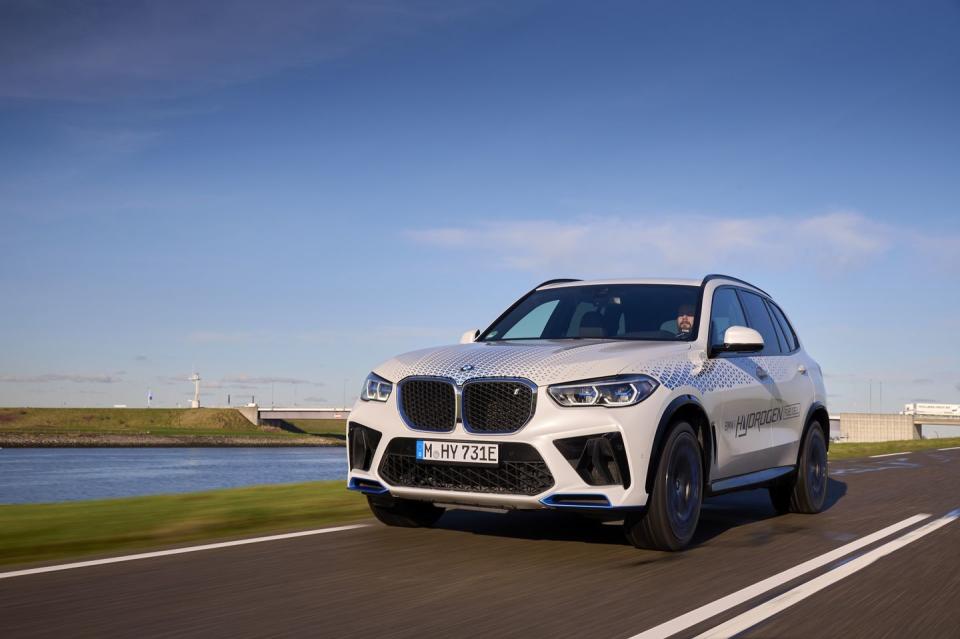A 2028 BMW Hydrogen Fuel-Cell Production Car Is Coming

BMW and Toyota announced today that they are collaborating on a hydrogen fuel-cell vehicle that will be out as a 2028 model. Whether it's coming to the U.S. is an open question for now.
The new vehicle will use Toyota's efficient third-generation fuel-cell stack.
While the automakers didn't say what vehicle will get the new powertrain, it could be an SUV to be built on the BMW Neue Klasse platform.
In a joint statement with Toyota, BMW announced today that it will put its first vehicle containing a hydrogen fuel-cell powertrain into series production in 2028.
BMW wouldn't reveal what type of vehicle would gain the new propulsion system. Its BMW iX5 Hydrogen variant, of which only 100 or so will be built, is a mid-size sport-utility vehicle. But given its claim that towing ability is a weakness of battery-electric cars that hydrogen powertrains can solve, an SUV seems a safe bet.

Michael Rath, vice president of hydrogen vehicles at BMW Group, said during a media briefing that BMW sees fuel-cell vehicles as EVs with a different energy-storage system. He stressed the electric motors, power electronics, and other components of the electric drive could be identical in both battery-electric and hydrogen fuel-cell vehicles. And, he said, BEVs and HFCV powertrains provide vehicles that are complementary—with hydrogen better for long distances, heavier vehicles, and towing—rather than competing with each other.

Hydrogen Neue Klasse EV?
Rath said the Neue Klasse EV architecture—to be used in EVs going into production next year in Hungary, Mexico, and later in China—could accept hydrogen tanks and a fuel cell in place of a large battery pack. BMW said the new vehicle will use Toyota's third-generation fuel-cell stack, which it expects to cost 50 percent less to make and offer 20 percent more range per kilogram of hydrogen.
If we had to bet, we'd say one of the future SUVs to be built on the Neue Klasse platform might gain a fuel cell in certain markets.
The question of markets, though, is where things get sticky. Rath said any market in which the fuel-cell variant is launched must have a "really dense" fueling infrastructure. He cited efforts in Japan, South Korea, and China to build hydrogen fueling stations and noted European Union regulations that require the construction of both DC fast-charging stations for EVs and hydrogen stations for fuel-cell vehicles.

While it's widely accepted that hydrogen will play a role in the global decarbonization of energy, it's less clear that it will have a role in personal transportation—especially in North America, where setting up DC fast-charging for EVs every 50 miles or so will be far less expensive than doing the same for hydrogen fueling that would serve an equivalent number of vehicles.
California's Troubling Experience with Hydrogen Cars
U.S. drivers have reason to be skeptical we will see a hydrogen-fueled BMW any time soon. California is the sole state with retail hydrogen fueling over the past 10 years. The state never received the promised 100 stations by 2020, and their reliability has been less than ideal. Indeed, a few of the existing 60 or so hydrogen stations are now being decommissioned. Sales of two generations of Toyota Mirai have totaled only 15,000 units since 2015, and many of those sales required heavy incentives. Sales of Honda and Hyundai hydrogen models are far lower.
BMW believes, as Toyota does, that inevitable development of hydrogen fueling stations for heavy commercial vehicles—Class 8 semi-tractors, for instance—will kick-start the needed U.S. fueling infrastructure. He stressed that all such stations must be amenable to both passenger vehicles and large trucks. It remains to be seen whether drivers of BMW SUVs want to fuel up next to semis, especially in industrial locations like port drayage lots or distribution warehouse centers where those semis spend time at rest.
How will those stations appear? Rath said the partners "are in close talks with infrastructure providers," including hydrogen producers and fuel distributors, and that BMW is working with Toyota to spur development of the needed infrastructure. Asked directly if the future hydrogen BMW production vehicle will be sold in the U.S., Rather replied, "We will have a really close look at how each region develops its hydrogen infrastructure." Individual markets for that vehicle will be announced "later."
Hydrogen as a Way to Export Clean Energy
Rath acknowledged that one of the main arguments for battery-electric vehicles is that they produce less carbon dioxide per mile than fuel-cell vehicles. But, he said, HFCVs can compete when the entirety of the energy ecosystem is taken into account—using so-called "green hydrogen" generated exclusively with renewable energy that would otherwise simply be shed from the grid. Today and for the near future, however, most hydrogen is created by using vast amounts of energy to "crack" natural gas, with carbon dioxide as the byproduct.
Renewable energy, solar in particular, is far more abundant in some regions than others, Rath noted. He suggested a scenario in which Portugal could generate far more solar energy than it needed; hydrogen would be the only way to export that clean energy to other regions, like cold and cloudy northern Germany.
To announce the expansion of their 10-year partnership in hydrogen vehicles, BMW chairman Oliver Zipse and Toyota president Koji Sato appeared together in a video.
Shown in the video were not only the current Toyota Mirai and the BMW iX5 Hydrogen, but also a 1979 BMW 5-series sedan with a hydrogen combustion engine and a fuel-cell-powered Toyota Hilux pickup truck. The first hydrogen-powered vehicle on public roads was the experimental GM Electrovan of 1966.
In the video, Sato drove Zipse to the front of BMW headquarters in Munich in a BMW iX5 Hydrogen and stressed the "sheer driving pleasure" that was possible in a fuel-cell-powered vehicle. Whether large numbers of American buyers will get to feel it for themselves is yet to be determined.
You Might Also Like

 Yahoo Autos
Yahoo Autos 